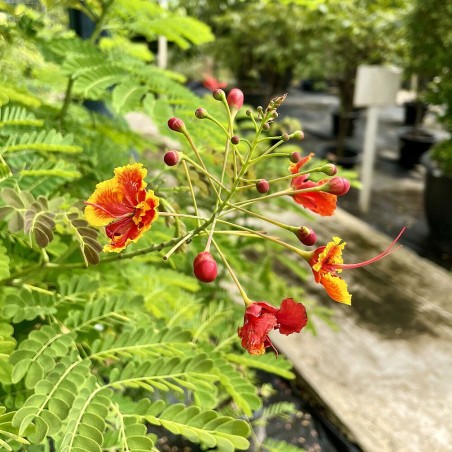






Caesalpinia pulcherrima is an ornamental plant from the Fabaceae family, native to the tropical regions of America, particularly the Antilles, the Caribbean, and Central America. It is known for its vibrant yellow and red flowers, which create a striking contrast. It is a shrub or small tree with a tropical habit, drought-resistant, and ideal for sunny, warm gardens. It attracts pollinators like bees and hummingbirds.
Caesalpinia pulcherrima is an ornamental plant from the Fabaceae family, native to the tropical regions of America, particularly the Antilles, the Caribbean, and Central America. This species is characterized by its shrub-like or small tree growth habit, reaching heights of 1.5 to 5 meters, depending on growing conditions.
The leaves of Caesalpinia pulcherrima are pinnate, composed of numerous small leaflets that are bright green in color, giving the plant a lush appearance. These leaves are sensitive to movement, partially closing at night or in low light, a feature typical of some species in the Fabaceae family.
The flowers are the main attraction of the plant. They are large, showy, and asymmetric, with a blend of bright colors, primarily yellow and red, creating a striking contrast. The flower has a complex structure, with elongated petals that stand out and long stamens, which contribute to its exotic appearance. These flowers are grouped in terminal clusters and typically appear on the plant for most of the year, especially in warm climates.
Regarding fruiting, Caesalpinia pulcherrima produces pods that are thin and elongated, containing several flat, dark brown seeds. The seeds, although decorative, are not edible and are primarily dispersed by the wind due to their lightweight structure.
The growth of this plant is relatively fast, and it is highly drought-resistant once established. It prefers well-drained, sunny soils, though it can tolerate some shade. It adapts well to tropical and subtropical climates and can withstand moderately cold temperatures, but it does not survive severe frosts. Additionally, Caesalpinia pulcherrima is highly valued for its ability to attract pollinators such as bees and hummingbirds, making it an excellent choice for gardens aimed at promoting biodiversity.
Finally, it is important to note that due to its rapid spread and adaptability to different growing conditions, Caesalpinia pulcherrima has become a popular ornamental plant in tropical and subtropical gardens, especially in areas where species with high aesthetic value and resilience to harsh conditions are sought.

| January | February | March | April | May | June | July | August | September | October | November | December |
Data sheet
No customer questions for the moment.